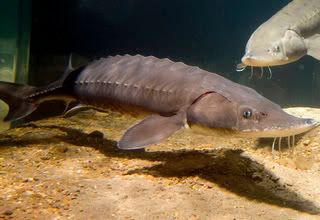 |
| Image from Tennessee Aquarium |
Think the 3-foot long lungfish with a 100-year lifespan isn’t enough? Howzabout the Lake Sturgeon (Acipenser fulvescens), right here in the Midwest, which, during its life of 150 years, can grow to 8 feet long. It has gigantic bony plates on its body, which grow smoother as it ages, because small spiky fish aren’t as digestible. The name “sturgeon” means “the stirrer” in various European languages (and, its scientific name means “reddish-yellow sturgeon” in Latin), which refers to its bottom-feeding habits. The “whiskers” (more technically barbules, which translates from Latin to… uh… whiskers) on their snout allow them to feel food items, such as crustaceans and small fish that are hiding under the substrate, which they suction up with their protruding mouth. Sound familiar?
As stated in the lungfish and tuatara posts, long life means one thing in the animal kingdom: slow to reproduce. Sturgeons take just as long to go through puberty as we do, reaching sexual maturity at 15 to 25 years of age, though they probably don’t have to worry about strange hair and cracking voices, what with being fish and all. Slow to reproduce means that this big fish is still getting over being used for meat, caviar, and isinglass (whatever that is). Pollution, damming, and the normal ol’ endangering factors still come into play.
Since this big bony fish has become protected in pretty much all of its range, the population has stabilized, even bumping it off the IUCN Redlist. It’s very much on its way to become one of those “Conservation Success Stories” like the bald eagle, but hopefully, when it’s pulled of the state endangered species lists, it gets some media attention too.

4 comments:
good picture
Isinglass
From Wikipedia, the free encyclopedia
Isinglass is a substance obtained from the swimbladders of fish (especially sturgeon), used mainly for the clarification of wine and beer. It is a form of collagen. Prior to inexpensive gelatin production and other competitive products, isinglass was used in confectionery and desserts such as Fruit Jelly and blancmange. Isinglass was originally made exclusively from sturgeon until the 1795 invention of a cheap substitute using cod by William Murdoch. This was extensively used in Britain in place of Russian isinglass. The bladders, once removed from the fish and processed, are formed into various shapes for use.
Isinglass finings are used extensively as a processing aid in the British brewing industry to accelerate the fining, or clarification, of beer. They are used particularly in the production of cask-conditioned beers, known as real ale, although there are a few cask ales available which are not fined using isinglass. The finings, a pure form of gelatin, flocculate the live yeast in the beer into a spongy mass, which settles to the bottom of the cask. Left to itself, beer will clear naturally, however the use of isinglass finings accelerates the process. Isinglass is sometimes used with an auxiliary fining, which further accelerates the process of sedimentation.
Non-cask beers which are destined for kegs, cans or bottles are often pasteurized and filtered. The yeast in these beers tend to settle to the base of the storage tank naturally, so the sediment from these beers can often be filtered without using isinglass. However, some breweries still use isinglass finings for non-cask beers, especially when attempting to repair bad batches.
Although very little isinglass remains in the beer which is drunk, many vegetarians consider beers which are processed with these finings to be unsuitable for vegetarian diets (although it is suitable for pescetarians). An alternative to isinglass which is suitable for vegetarians, is Irish moss, a type of red alga. The process differs, however: isinglass is added at end of the brewing process, before bottling, whereas Irish moss is added to the hot wort while it is being boiled, and primarily reduces hazes caused by proteins. Since the two fining agents act differently, some beers will make use of both.
Superstar: I can't claim that picture in any way. I Google Image Searched and saw the Tennesee Aquarium had a good one: http://www.tennis.org/Newsroom/Photo_library.asp
Drew: I saw, I linked there.
D'ohh!
Post a Comment